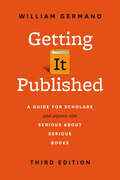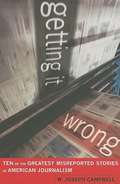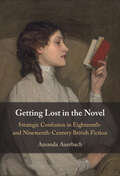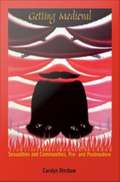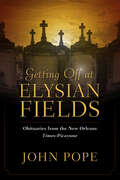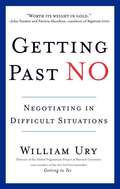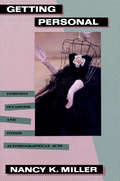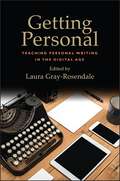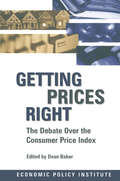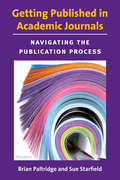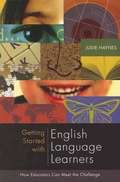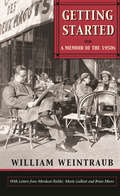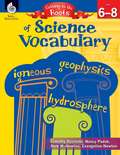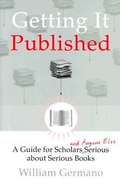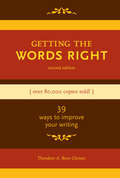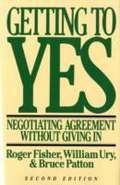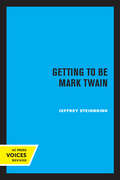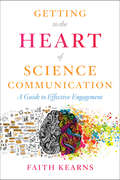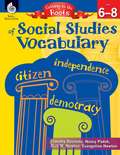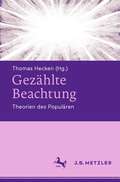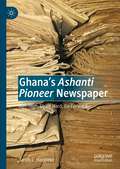- Table View
- List View
Getting It Published: A Guide for Scholars and Anyone Else Serious about Serious Books, Third Edition (Chicago Guides to Writing, Editing, and Publishing)
by William GermanoFor more than a decade, writers have turned to William Germano for his insider’s take on navigating the world of scholarly publishing. A professor, author, and thirty-year veteran of the book industry, Germano knows what editors want and what writers need to know to get their work published. Today there are more ways to publish than ever, and more challenges to traditional publishing. This ever-evolving landscape brings more confusion for authors trying to understand their options. The third edition of Getting It Published offers the clear, practicable guidance on choosing the best path to publication that has made it a trusted resource, now updated to include discussions of current best practices for submitting a proposal, of the advantages and drawbacks of digital publishing, and tips for authors publishing textbooks and in open-access environments. Germano argues that it’s not enough for authors to write well—they also need to write with an audience in mind. He provides valuable guidance on developing a compelling book proposal, finding the right publisher, evaluating a contract, negotiating the production process, and, finally, emerging as a published author. “This endlessly useful and expansive guide is every academic’s pocket Wikipedia: a timely, relevant, and ready resource on scholarly publishing, from the traditional monograph to the digital e-book. I regularly share it, teach it, and consult it myself, whenever I have a question on titling a chapter, securing a permission, or negotiating a contract. Professional advice simply does not get any savvier than this pitch-perfect manual on how to think like a publisher.”—Diana Fuss, Princeton University
Getting It Wrong: Ten of the Greatest Misreported Stories in American Journalism
by W. Joseph CampbellW. Joseph Campbell addresses and dismantles prominent media-driven myths--stories about or by the news media that are widely believed but which, on close examination, proves apocryphal.
Getting Lost in the Novel: Strategic Confusion in Eighteenth- and Nineteenth-Century British Fiction
by Amanda AuerbachInstances abound in eighteenth- and nineteenth-century novels where characters, particularly female characters, become lost, often moved by overwhelming emotion. Amanda Auerbach delves into the impact of these scenes on the character and the reader. On one level, 'getting lost' can realign a character's and our own sense of self and of social situation, while more broadly these instances reflect arcs within the overall narrative, highlighting easily-missed elements, sometimes even reflecting on our own experiences while reading. The emotions that move characters most powerfully often relate to their psychological needs, which the social conditions of their lives prevent them from meeting or fully acknowledging. These episodes appear across multiple novels in multiple subgenres, including the marriage plot, the gothic novel, the Victorian bildungsroman, and the sensation novel. These episodes collectively reveal how eighteenth- and nineteenth-century British novelistic subgenres developed to help women and working-class readers covertly satisfy their psychological needs.
Getting Medieval: Sexualities and Communities, Pre- and Postmodern
by Carolyn DinshawIn Getting Medieval Carolyn Dinshaw examines communities--dissident and orthodox--in late-fourteenth and early-fifteenth-century England to create a new sense of queer history. Reaching beyond both medieval and queer studies, Dinshaw demonstrates in this challenging work how intellectual inquiry into pre-modern societies can contribute invaluably to current issues in cultural studies. In the process, she makes important connections between past and present cultures that until now have not been realized. In her pursuit of historical analyses that embrace the heterogeneity and indeterminacy of sex and sexuality, Dinshaw examines canonical Middle English texts such as the Canterbury Tales and The Book of Margery Kempe. She examines polemics around the religious dissidents known as the Lollards as well as accounts of prostitutes in London to address questions of how particular sexual practices and identifications were normalized while others were proscribed. By exploring contemporary (mis)appropriations of medieval tropes in texts ranging from Quentin Tarantino's Pulp Fiction to recent Congressional debates on U. S. cultural production, Dinshaw demonstrates how such modern media can serve to reinforce constrictive heteronormative values and deny the multifarious nature of history. Finally, she works with and against the theories of Michel Foucault, Homi K. Bhabha, Roland Barthes, and John Boswell to show how deconstructionist impulses as well as historical perspectives can further an understanding of community in both pre- and postmodern societies. This long-anticipated volume will be indispensible to medieval and queer scholars and will be welcomed by a larger cultural studies audience.
Getting Off at Elysian Fields: Obituaries from the New Orleans Times-Picayune
by John PopeNo city in America knows how to mark death with more funerary panache than New Orleans. The pageants commemorating departed citizens are often in themselves works of performance art. A grand obituary remains key to this Stygian passage. And no one writes them like New Orleanian John Pope. Collected here are not just simple, mindless recitations of schools and workplaces, marriages, and mourners bereft. These pieces in Getting Off at Elysian Fields: Obituaries from the New Orleans “Times-Picayune” are full-blooded life stories with accounts of great achievements, dubious dabblings, unavoidable foibles, relationships gone sour, and happenstances that turn out to be life-changing. To be sure, there are stories about Carnival monarchs, great philanthropists, and a few politicians. But because New Orleans embraces eccentric behavior, there are stories of people who colored way outside the lines. For instance, there was the doctor who used his plasma to make his flowers grow, and the philanthropist who took money she had put aside for a fur coat to underwrite the lawsuit that desegregated Tulane University. A letter carrier everyone loved turned out to have been a spy during World War II, and a fledgling lawyer changed his lifelong thoughts about race when he saw blind people going into a Christmas party through separate doors—one for white people and another for African Americans. Then there was the punctilious judge who got down on his hands and knees to edge his lawn—with scissors. Because New Orleans funerals are distinctive, the author includes accounts of four that he covered, complete with soulful singing and even some dancing. As a popular, local bumper sticker indisputably declares, “New Orleans—We Put the Fun in Funeral.”
Getting Past No: Negotiating Your Way from Confrontation to Cooperation
by William UryBook discusses negotiation skills in a user friendly way. Applies to multiple disciplines and personal issues.
Getting Personal: Feminist Occasions and Other Autobiographical Acts
by Nancy K. MillerIn the era of identity politics, whose is the I of cultural criticism? And what does the invention of an autobiographical persona have to do with contemporary theory? In Getting Personal, Nancy K. Miller reflects upon the ways in which contingencies of identity and location shape the writing of academic argument and the living of an academic life. Getting Personal explores the new territory of feminist cultural studies and its connections to literary interpretation. The book is organized around a number of academic scenes in which Miller analyses the stakes of feminist critical performance. The focus on occasions, from the conference to the seminar to the professional colloquium, produces an autobiographical perspective on the mini-drama of institutional politics - whether faculty struggles over the canon in elite universities, or student strivings for self-authorization in large urban ones. Writing as a feminist critic, Miller describes the dilemmas of a responsible pedogogic practice: the contradictory demands of authority and complicity for a feminist teacher of literature.Getting Personal examines the rhetorical strategies of a feminism traversed by internal debates over its own self-representations. Working through and among quotations of voices that might otherwise not address each other, Miller assesses a crisis and offers a project for moving on.
Getting Personal: Teaching Personal Writing in the Digital Age
by Laura Gray-RosendaleSilver Medalist, 2019 Independent Publisher Book Awards in the Education (Commentary/Theory) CategoryAt a time when Twitter, Facebook, blogs, Instagram, and other social media dominate our interactions with one another and with our world, the teaching of writing also necessarily involves the employment of multimodal approaches, visual literacies, and online learning. Given this new digital landscape, how do we most effectively teach and create various forms of "personal writing" within our rhetoric and composition classes, our creative writing classes, and our community groups? Contributors to Getting Personal offer their thoughts about some of the positives and negatives of teaching and using personal writing within digital contexts. They also reveal intriguing teaching activities that they have designed to engage their students and other writers. In addition, they share some of the innovative responses they have received to these assignments. Getting Personal is about finding ways to teach and use personal writing in the digital age that can truly empower writing teachers, writing students, as well as other community members.
Getting Prices Right: Debate Over the Consumer Price Index
by Dean BakerCompiled by the Bureau of Labor Statistics, the CPI is used to index Social Security payments and many other federal programs, as well as to adjust tax brackets. Today, the accuracy of the CPI is being hotly debated, particularly in light of the Boskin Commission report that concluded in December 1996 that the CPI overstates inflation by 1.1%. If accepted and applied in the formulation of economic policy, the report would have major implications for balancing the federal budget. It would have a direct impact on the lives of Americans who are beneficiaries of government programs as well as on everyone who pays taxes. In this book, Dean Baker introduces and explains the significance of the debate, presents the full text of the Boskin Commission report and finally discusses in a far-reaching and insightful analysis both the Commission's research methodology and its conclusions.
Getting Published in Academic Journals: Navigating the Publication Process
by Sue Starfield Brian Richard PaltridgeThe pressure on graduate students and new PhDs to publish their work continues to grow with writing and publishing considered an important measure of career success within the academy. There is, however, more to the process of getting published than those who are new to the process initially realize. The aim of this guide is to clarify the process and offer advice. Getting Published in Academic Journals is written for graduate students and newly graduated PhDs who want to publish their research in peer-reviewed academic journals. Getting Published in Academic Journals draws on the experiences of the authors as editors of peer-reviewed journals, as teachers of writing-for-publication courses and workshops, as researchers of the scholarly publication process, as reviewers of hundreds of articles, and as published authors. The book is written to be used in courses and workshops on publishing, as a supplement to the books in the revised and updated English in Today's Research World (Swales & Feak) series, and as a stand-alone guide for academic writers working independently. Book jacket.
Getting Started With Beginning Writers
by Katie Wood Ray Lisa B. CleavelandHow can I help my youngest students become writers? How can I establish a routine for writing in my classroom? Why is making books developmentally appropriate? In Lisa Cleaveland's classroom, writing workshop is a time every day when her students make books. Katie Wood Ray guides you through the first days in Lisa's classroom, offering ideas, information, strategies, and tips to show you step by step how you can launch primary writing workshop with beginning writers. If you're a new teacher or new to writing workshop, A Teacher's Guide to Getting Started with Beginning Writers will show you in clear and simple terms what to do to establish a routine for writing in your classroom, offering you vision, insight, and practical support. If you're an experienced workshop teacher, Katie and Lisa will help you imagine new possibilities.
Getting Started with English Language Learners: How Educators Can Meet the Challenge
by Judie HaynesIn Getting Started with English Language Learners: How Educators Can Meet the Challenge, Judie Haynes provides a practical resource to help educators who are new to the field of English as a Second Language understand the needs of English language learners. From learning how students acquire a second language to differentiating instruction to exploring practical strategies for teaching newcomers, this book will help educators learn how to create effective learning environments for English language learners.
Getting Started: A Memoir of the 1950s
by William WeintraubWith letters from Mordecai Richler, Mavis Gallant, and Brian Moore, Getting Started is a wonderful memoir, a collection of extraordinary letters, and a brilliant recreation of a time when Canadian writers were set to make their mark in the world for the first time. Writer Brian Moore emigrated from Ireland to Canada in the late 1940s and found work at the Montreal Gazette, where he also found William Weintraub embarking upon a career as a freelance journalist. When he travelled to Paris, Weintraub saw an old friend and former Gazette writer, Mavis Gallant, who filled him in on the tribulations of the expatriate writer's life ("My room is enormous and the radiator very small indeed"). Gallant introduced Weintraub to another Montreal writer, Mordecai Richler, also pursuing a career as a novelist while living a gloriously Bohemian life. Weintraub joined Richler for a while in Ibiza (he later introduced him to Brian Moore), and later they kept in touch. ("Dear Bill: I got your highly unintellectual letter yesterday and it confirmed my suspicions that you slipped a chair under your arse in the Deux Magots as soon as you arrived in Paris and probably haven't moved since.")In these years, Gallant had her short stories published for the first time in the New Yorker, Moore methodically churned out money-making thrillers while working on The Lonely Passion of Judith Hearne, and Richler wrote his first acclaimed book, The Acrobats. Weintraub, meanwhile, returned to Montreal, where he saw published his brilliant comic novel, Why Rock the Boat? William Weintraub weaves together his own memories of the 1950s with letters both to and from his literary colleagues. The letters and his recollections are always fascinating, often hilarious, and provide intimate insight into the lives and work of some of Canada's finest contemporary writers.
Getting To The Roots Of Science Vocabulary
by Timothy Rasinski Nancy Padak Rick M. NewtonMake learning science vocabulary fun and interesting with a roots approach! This resource, geared towards secondary grades, focuses on root words for science. Teaching tips and strategies, standards-based lessons, and student activity pages are included to make teaching a breeze and learning fun! By implementing the resources provided in this book into your vocabulary instruction, students will learn to expand their vocabularies by learning how words are built from the roots up!
Getting it Published
by William GermanoA Guide for Scholars and Anyone Else Serious About Serious Books (Chicago Guides to Writing, Editing, and Publishing)
Getting the Words Right: 39 Ways to Improve Your Writing (2nd Edition)
by Theodore A. Rees CheneyThe Secret to Good Writing When asked by the Paris Review what compelled him to rewrite the ending of A Farewell to Arms 39 times, Ernest Hemingway replied, "Getting the words right." His answer echoes what every successful writer knows: The secret to all good writing is revision. For more than twenty years, Getting the Words Right has helped writers from all professions rewrite, revise, and refine their writing. In this new edition, author Theodore Cheney offers 39 targeted ways you can improve your writing, including how to: create smooth transitions between paragraphs correct the invisible faults of inconsistency, incoherence, and imbalance overcome problems of shifting point of view and style express your ideas clearly by trimming away weak or extra words You'll strengthen existing pieces and every future work by applying the three simple principles—reduce, rearrange, and reword. Once the secrets of revision are yours, you'll be able to follow Hemingway's lead—and get the words right!
Getting to Yes: Negotiating Agreement Without Giving In (Fifth Edition)
by William Ury Roger Fisher Bruce PattonA straightforward, universally applicable method for negotiating personal and professional disputes without getting taken- and without getting angry Getting to YES offers a concise, step-by-step, proven strategy for coming to mutually acceptable agreements in every sort of conflict-whether it involves parents and children, neighbors, bosses and employees, customers or corporations, tenants or diplomats. Based on the work of the Harvard Negotiation Project, a group that deals continually with all levels of negotiation and conflict resolution from domestic to international, Getting to YES tells you how to separate the people from the problem, focus on interests, not positions, work together to create options that will satisfy both parties, and negotiate successfully with people who are more powerful, refuse to play by the rules, or resort to "dirty tricks."
Getting to be Mark Twain
by Jeffrey SteinbrinkMark Twain is one of our most accessible cultural icons, a figure familiar to virtually every American and renowned internationally. But he was not always as we know him today. Mark Twain began life as a loose gathering of postures, attitudes, and voices in the mind of Samuel Clemens. It was some time before he took full possession of the personality the world now recognizes. This is the story of the coming of age of Mark Twain. It begins in 1867, with Clemens stepping off the steamship Quaker City and almost immediately declaring himself "in a fidget to move." It comes to a close in 1871, with Clemens settling in Hartford. Mark Twain was substantially formed during the intervening years, as Clemens came East, gained fame and fortune with the publication of Innocents Abroad, courted and married Olivia Langdon, and established himself as a professional writer. Each of these steps represented a profound change in the former Wild Humorist of the Pacific Slope as he sifted through the elements in his personality and began to assume the qualities we now associate with him. The tale that unfolds here shows how, through that process, the Mark Twain of the late 1860s became the Mark Twain of all time. This title is part of UC Press's Voices Revived program, which commemorates University of California Press’s mission to seek out and cultivate the brightest minds and give them voice, reach, and impact. Drawing on a backlist dating to 1893, Voices Revived makes high-quality, peer-reviewed scholarship accessible once again using print-on-demand technology. This title was originally published in 1991.
Getting to the Core of English Language Arts, Grades 6-12: How to Meet the Common Core State Standards with Lessons from the Classroom
by Vicky M. Giouroukakis Dr Maureen ConnollyDesign effective CCSS-aligned lessons for secondary students If you want to revamp your secondary English Language Arts curriculum to reflect the Common Core State Standards, this book is the perfect resource. The authors move the implementation of the CCSS for ELA from the abstract to the concrete by providing adaptable, exemplar lesson plans in each of the CCSS strands: reading, writing, speaking and listening, and language. Each lesson template includes: Intended grade level band, timeline, and the type of student writing involved Connections to supporting theory, including the Backward Design model Variations to differentiate lessons for diverse student populations Ways to link the lesson to technology and service learning Reproducible handouts
Getting to the Heart of Science Communication: A Guide to Effective Engagement
by Faith KearnsScientists today working on controversial issues from climate change to drought to COVID-19 are finding themselves more often in the middle of deeply traumatizing or polarized conflicts they feel unprepared to referee. It is no longer enough for scientists to communicate a scientific topic clearly. They must now be experts not only in their fields of study, but also in navigating the thoughts, feelings, and opinions of members of the public they engage with, and with each other. And the conversations are growing more fraught. In Getting to the Heart of Science Communication, Faith Kearns has penned a succinct guide for navigating the human relationships critical to the success of practice-based science. This meticulously researched volume takes science communication to the next level, helping scientists to see the value of listening as well as talking, understanding power dynamics in relationships, and addressing the roles of trauma, loss, grief, and healing.
Getting to the Roots of Social Studies Vocabulary, Grades 6-8
by Timothy Rasinski Nancy Padak Rick M. Newton Evangeline NewtonMake learning social studies vocabulary fun and interesting with a roots approach! This resource, geared towards secondary grades, focuses on root words for social studies. Teaching tips and strategies, standards-based lessons, and student activity pages are included to make teaching a breeze and learning fun! By implementing the resources provided in this book into your vocabulary instruction, students will learn to expand their vocabularies by learning how words are built from the roots up!
Gezählte Beachtung: Theorien des Populären
by Thomas HeckenTheorien des Populären setzen bisher oftmals bei sozialen Verhältnissen an (z.B. populäre Kultur als Kultur der machtlosen ‚niederen‘ Schichten) oder bestimmen das Populäre über die Merkmale der so bezeichneten Artefakte (etwa als Gegenteil der autonomen, komplexen ‚high art‘). Gemäß dem Diktum „Populär ist, was bei vielen Beachtung findet“ geht dieser Band einen anderen Weg – im Mittelpunkt stehen Dimensionen des Quantitativen. Populär ist demnach, was in relativ großer Zahl angeklickt, gekauft, rezipiert und dessen Häufigkeit in Top-Ten-Listen oder anderen Rankings behauptet wird. Im Lichte dieser Bestimmung werden bisherige Theorien des Populären diskutiert und neue Forschungsansätze erprobt.
Ghalib: The Poet and his Age (Routledge Revivals)
by Ralph RussellFirst published in 1972, Ghalib presents aspects of Ghalib, the last great literary figured produced by Mughal India before the empire was swept away by the British after the Revolt of 1857, as he appears though the eyes of well-known British and other European scholars. The book gives a picture of Ghalib’s own personality as it emerges in passages from his own Persian and Urdu letters and prose writings. Percival Spear, who lived in Delhi for many years, describes the Delhi scene of Ghalib’s day. P. Hardy writes of his relations with the British, and finally, two essays, by A. Bausani and Ralph Russell respectively, give an account of his Persian and Urdu poetry. His book will be of interest to students of literature, poetry, South Asian studies and history.
Ghana’s Ashanti Pioneer Newspaper: Aim High, Strive Hard, Go Forward
by Jarvis L. HargroveThis book is a history of a prominent Ghanaian newspaper, the Ashanti Pioneer, as well as well-known figurers in the country itself. It utilizes the stories published in the newspaper to recount the history of the press, including its key individuals and groups, and to provide a unique perspective on the most important events in the Gold Coast during the mid-twentieth century, just prior to and after independence. This work will show that the Ashanti Pioneer influenced public opinion on several subjects. From its opening in 1939, the newspaper contributed greatly to the spread of newsworthy information throughout Ghana, formerly known as the Gold Coast, from Kumasi to the coastline and to its Northern borders. Readers interested in African History, independence movements and newspaper history will find this work insightful.
